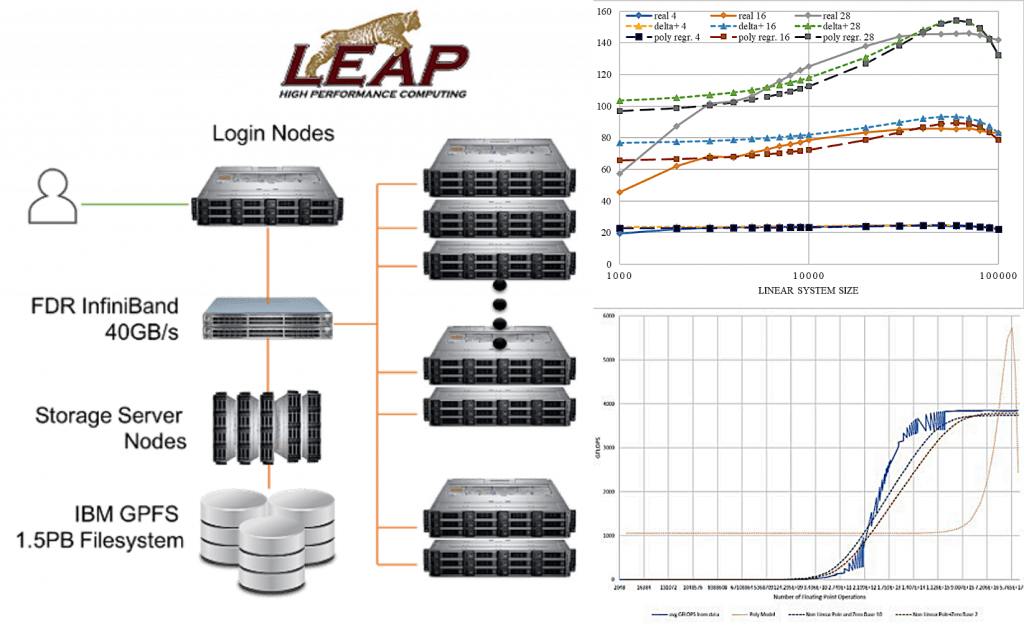
Timeframe:
Spring 2018 – Fall 2019
Students:
David Johnson
Overview:
The purpose of this work is to benchmark and model the performance of the hardware components of our Dell Servers with GPUs and the LEAP Cluster. The modeling work will provide information on the capabilities and maximum loads that our servers can handle for other research projects.
Stages
Phase 1:
The purpose of this stage was to perform several benchmarks on Texas State University’s LEAP Cluster and analyze the data collected from those tests to determine performance models. The tests used to collect this data will be various benchmarking programs:
>> High-Performance Linpack (HPL) (CPU)
>> IOZone (Hard drive)
>> CacheBench (Memory)
Phase 2:
The networking model makes use of the Intel MPI Benchmarks, linear polynomial regression, and arithmetic manipulation to produce a second-order polynomial model of the Infiniband networking subsystem that connects the different compute nodes of the LEAP cluster. The final model is the integration of the polynomial models of the memory, filesystem, CPU, and networking systems, as well as the size of the program
Phase 3:
The evaluation of a consolidated linear performance model of the LEAP cluster and the development of a non-linear model to represent the performance of the NVIDIA V100 Graphics Processing Unit (GPU). The GPU’s performance analysis was done by first collecting performance data then using non-linear methods to model it. The final model is based on logarithmic functions that mapped the GPU performance to a semi-logarithmic scale of the number of floating-point operations.
Publications:
- D. Johnson, D. Valles, “An Initial Scale-Factor Linear Polynomial Regression Model Approach for Hardware Performance on an HPC Compute-Node,” The 9th IEEE Annual Information Technology, Electronics & Mobile Communication Conference (IEMCON’18), Vancouver, Canada, 2018, pp. 661-666, doi:10.1109/IEMCON.2018.8614937
- D. A. Johnson, D. Valles, “A Linear Approach to Network Performance Modeling and a Consolidation of Linear Performance Models of the LEAP Cluster,” The 2019 World Congress in Computer Science, Computer Engineering, & Applied Computing –The 17th International Conference on Scientific Computing (CSCE-CSC’19), Las Vegas, NV, 2019, pp. 132-135, ISBN: 1-60132-494-4.
- D. Johnson and D. Valles, “A Non-Linear GPU Performance Modeling Approach and Consolidated Linear Hardware Model Performance Evaluation of the LEAP Cluster,” 2020 10th Annual Computing and Communication Workshop and Conference (CCWC), Las Vegas, NV, USA, 2020, pp. 0517-0523, doi:10.1109/CCWC47524.2020.9031282
Posters:
- David A.S. Johnson, D. Valles, “Modeling of High-Performance Computing Servers using Analysis of Benchmarks,” The 2018 SACNAS – The National Diversity in STEM Conference, San Antonio, TX, 2018
- David A.S. Johnson, D. Valles, “Performance Modeling High-End Servers Using Benchmark Analysis,” TECHCON 2018, Austin, TX, 2018
- David A.S. Johnson, D. Valles, “Modelling of High-Performance Computing Servers using Analysis of Benchmarks,” 2018 Women in Science and Engineering (WiSE) Annual Conference, Texas State University, San Marcos, TX, 2018


